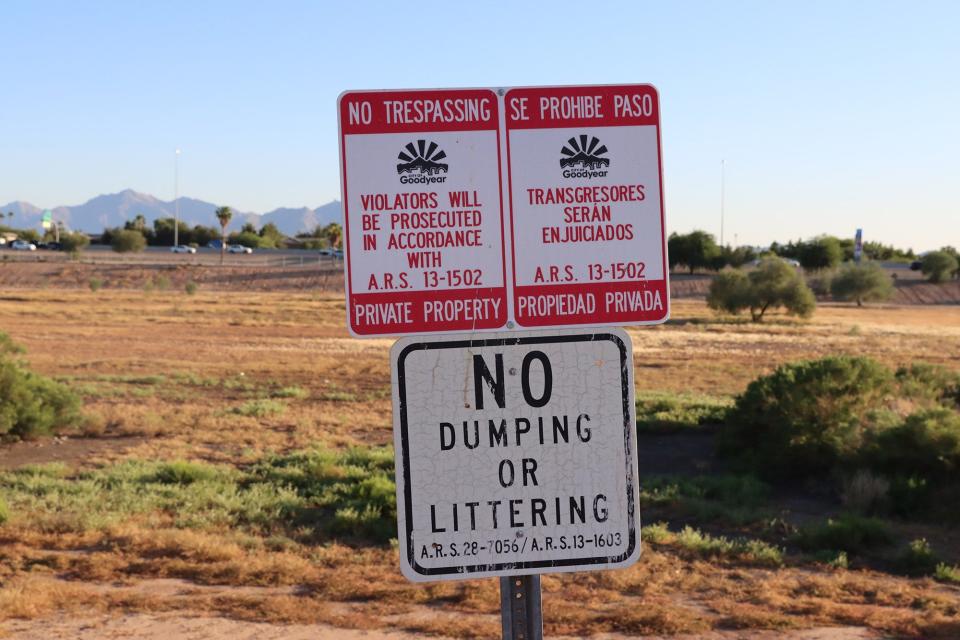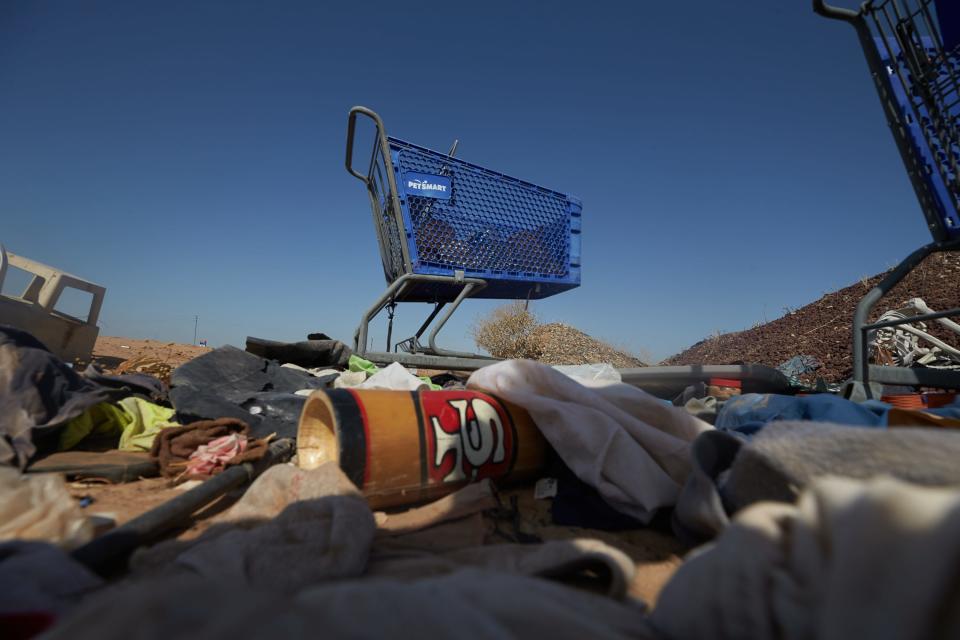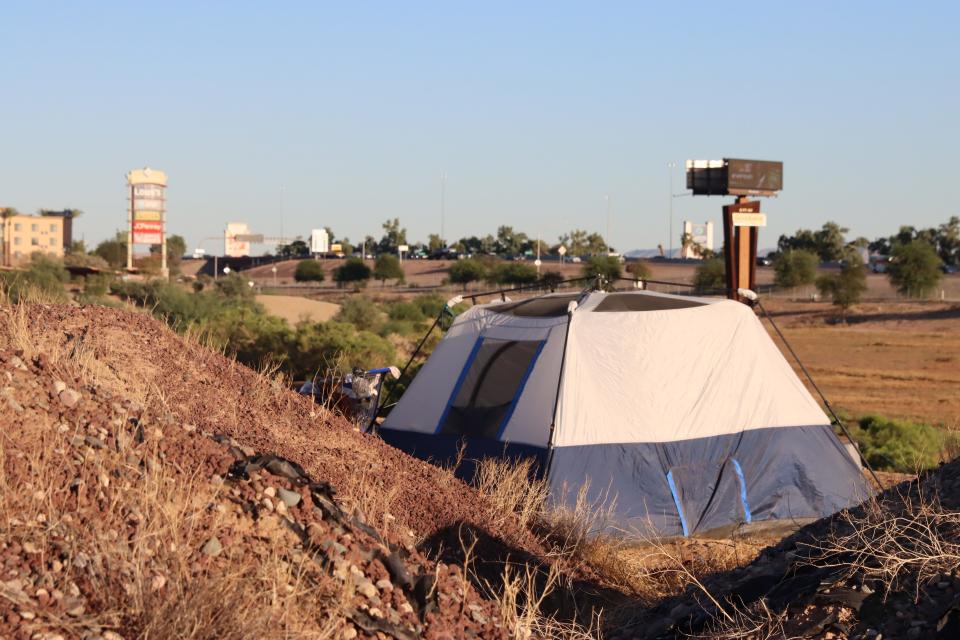Trespassing citations become constant worry for those living on the streets
As Edna Smith takes a blue marker to a cardboard sign — adding a colorful outline to a heart-dotted message that wishes readers a “very safe and blessed day” and proclaims that “God loves you” — she makes sure her feet are planted firmly on the sidewalk.
She has a right to set up here, in the public right-of-way on the corner of Dysart Road and Rancho Santa Fe Boulevard near a bustling shopping and food district in Goodyear.
But she still glances back warily at the fast food restaurant on the corner, whose property manager has called the police on her before just for standing there.
“The last time he done that, the police told him, ‘Well, we can’t do nothing to them because they’re not on your property,’” recalled Smith, 56, a diminutive woman with a hint of a Florida drawl in her voice. “The sidewalk is public.”
Advocates and people experiencing homelessness say interactions like these have become more common in recent years, as police across the Phoenix area have increasingly pivoted to trespassing citations as a tool to address the growing challenge of homelessness.
But this type of enforcement can be far from straightforward for officers, who often find themselves caught in the push and pull between business owners who want the city to do more and the constitutional rights of those who live on the streets.
Goodyear Police Department Officer David Mitterbauer, a member of the city’s Homeless Outreach Team, says some people in the city are “adamant that we need to enforce all the panhandling laws and all the laws against transients we can and we need to arrest them all and take them to other cities.”
“At the same time, I also know the legal ramifications of what we can and can't do,” he said in a recent interview. “I know the social aspect of what we should do. And you’ve got to have that balance. We can't just round them all up.”
But even as Mitterbauer contends Goodyear is striking the right balance with its enforcement — which is coupled with outreach efforts meant to get people off of the streets — some critics see the move toward trespassing citations across several Maricopa County cities as simply the latest way for officers to circumvent court rulings prohibiting the criminalization of homelessness.
“It’s sort of a proxy for just enforcing the urban camping,” said Elizabeth Venable, an organizer with the Fund for Empowerment, a Phoenix-based group that advocates for the rights of those on the streets. “And I think it’s actually a really weak one, because it’s really an obvious type of pattern and practice of discrimination.”
Trespassing cases are now among the most common offenses addressed in the handful of homeless courts across Maricopa County, according to several court administrators, though none of the courts was able to provide data on how often they’re seeing these case types.
These so-called “lifestyle crimes” can be difficult for people experiencing homelessness to avoid when there’s no space in the shelters.
Stacey Good, assistant city prosecutor with the Mesa Community Court, noted that people experiencing homelessness often have a hard time finding a place to sleep at night, “so they end up sleeping in the back of a parking lot or somewhere in the back of the building.”
“And that’s a trespass,” she said. “And they end up getting arrested and cited for that.”

Jennifer Webber, a recent graduate of Mesa’s program, came to the court late last year as a result of a trespassing ticket. She was sleeping in an area where she said she hadn’t seen any “no trespassing signs,” and she noted that she made a point to keep the area clean. But that didn’t stop officers from citing her after someone called to complain.
“Even if you’re just sleeping,” she said, “they still call it trespassing.”
‘They come back’
The move to trespassing enforcement comes as the number of people experiencing homelessness has grown across the state and in Goodyear — and as officers in Arizona have lost several of the tools they once relied upon to address the business and resident complaints that sometimes surface when people live outside.
A 2015 Supreme Court free speech ruling has limited officers’ ability to enforce bans against panhandling. And a 9th Circuit Court of Appeals decision in 2018 has barred police from citing people experiencing homelessness for setting up urban camps if they don’t have access to shelter beds.
In Phoenix: Airport shelter provides relief from heat
Those rulings “pretty much quashed everything” for police, Mitterbauer said.
By contrast, there are few constitutional guardrails around the use of trespass authorizations, which are generally requested by private property owners and give police the power to “arrest anyone on site during non-operational hours or not conducting legitimate business” at a particular location, as Mitterbauer explained it.
Goodyear’s city code defines trespassing broadly, stating that someone is guilty of the crime if they “knowingly” come or stay somewhere they are not “authorized, invited, or otherwise privileged” to be. Not everyone who receives a trespassing notice is living on the streets, but Mitterbauer said most of the authorizations he sees are “for businesses that have a problem with the homeless.”
The trespass authorizations that dot the city in Goodyear sometimes cover entire commercial plazas, according to a database maintained by the city’s Homeless Outreach Team. While police are not allowed to push people from public property, like parks, unless it’s after hours, Goodyear does have a trespassing authorization covering a city-owned retention basin that floods during monsoon season.
Some businesses request authorizations or increased enforcement after people experiencing homelessness leave their property in disarray, as happened recently at the AT&T on Dysart Road, which was littered with the remnants of a camp, including two shopping carts and a used syringe.

Jim Neal, a Prescott resident who owns a strip of properties on Van Buren Street in Goodyear, first requested a trespass authorization for that land in October 2014, at a time when he said the problems associated with people experiencing homelessness began to spike in the area.
The space behind his properties has a covered parking lot, which was meant as an amenity for tenants but has also served as a “magnet” for unsheltered people seeking shade on hot Arizona days, he said.
One of his tenants’ employees had the gas tank in her car punctured. He’s closed off portions of the back of his building where people would set up camps. And he caged off the water spigots after someone turned one on and never shut it off, leaving him with a surprisingly high bill one month.
But while he said the trespassing authorization has led to increased enforcement at his property, Neal said it’s not a permanent solution.
“We step up the patrol activity at my property and that drives them off for a while,” he said. “And they go to someone else’s property and then (police) start enforcing it there and then they come back to mine.”
He said he recognizes that some people on his property likely face mental health challenges but added that he doesn’t have “much sympathy” for the plight that draws them to his business strip.
“I’m driven by my tenants and I put their well-being first,” Neal said. “I mean, they’re paying money and if the homeless people are having an impact — a negative impact — on their business and their ability to be successful, my first responsibility has to (be to) provide the best environment I can for them to be successful.”
‘Places you can and can't go’
As swaths of the city have effectively been closed off to them, people experiencing homelessness in Goodyear — which does not have a shelter — have been left with fewer spaces where they can rest during the day or sleep at night without fear of facing a Class 1 misdemeanor.
But while trespassing can carry a penalty up to six months in jail, it’s rare that enforcement goes that far.
Smith and several other people experiencing homelessness said they usually receive a trespass notice — which does not require a court appearance or payment of any fines — the first time they’re found in a location where a business owner has requested police move people along.

“That’s the way I learn what places you can and can’t go,” Smith said.
Once they receive a trespass notice, people on the streets can’t come back to that property for a year. Only if they’re found in a spot where they had previously received a trespassing notice will they receive more stringent discipline.
Most people don’t come back after they receive a trespassing notice, Mitterbauer said, so he hasn’t had to issue citations to many people. But although punishments are usually “progressive,” he said officers have broad discretion in how to handle these situations.
“To be quite honest, a lot of what I do and how much enforcement I take will depend on how they are with me,” Mitterbauer said. “If I have someone that is a complete jerk, and I walk up and I just say ‘hi’ and I'm starting to get yelled at, more than likely they're going to get arrested on the spot. If I have someone that's polite and just respectful, I'll give them the benefit of the doubt.”
It’s also up to the discretion of property owners to request a trespassing authorization. While some seek enforcement because of vandalism, drug use or other problems at their property, they don’t have to prove someone is causing trouble to push someone from the business.
That’s why Mitterbauer said he’s advised some people on the streets to stay out of sight in order to avoid a run-in with police.
“I've told a lot of them, ‘If you're in the front of a business where everyone can see you, people are going to call,’” he said. “That's just how it is.”
Regardless of whether they receive a citation, several people experiencing homelessness indicated that these interactions can be frustrating — underscoring the message that they’re not welcome in the community and that most people would prefer their plight was out of sight and out of mind.
In some places, Smith argues, “it’s nonsense to be called, because you’re not on their property and you bring them more business than harming their business.”
“Because people will go in, go through, buy you food from there and stuff,” she said. “So that’s helping their business, not ruining it, you know? I don’t get when they say we’re ruining it, because we’re not.”
‘They’re doing their job’
The trend of increased trespassing enforcement isn’t isolated to Goodyear. Venable, the community organizer who’s opposed to use of the policing method, said she’s heard from people on the streets about increasing use of the tactic across Maricopa County.
She knows unsheltered people who have received trespass notices just for leaning against a building, she said. And some people have received multiple citations, which has made it more difficult for them to obtain housing or secure a job.
Venable is lobbying to end the practice of trespassing enforcement in Phoenix, which is the main hotspot for homelessness in the state.
But she believes there are challenges in rallying support behind the cause.
“People are not sympathetic to, let’s say, blight, what they consider as blight,” she said. “And they wonder why people so-called ‘choose’ not to be in shelters, not realizing that there is not enough shelter capacity despite recent federal funding increases from the city of Phoenix.”
But while trespassing enforcement has its critics, policy makers in Goodyear, at least, seemed receptive to the approach during a City Council work session last fall, where the city’s Homeless Outreach Team explained the use of the tool and also described its outreach efforts to the homeless community.
Councilman Bill Stipp said then that he didn’t want to see people pushed into a “revolving” door to the courthouse. But he indicated that he does see a need for some enforcement to address the impacts that business owners face from homelessness.
“For the folks that want to make this a lifestyle, then we’ve got to keep them within their rights but not infringing on those of others,” he said. “So I really appreciate the effort you guys have done.”
As they go out on patrols each day, police will continue to be called upon to weigh the rights of people experiencing homelessness in response to requests from property owners to push the population out of sight and out of mind.
While many disagree on whether the enforcement goes too far or not far enough, Smith, at least, says she’s sympathetic to the part officers have to play.
“We’ve got to realize that they’re doing their job. If we hadn’t walked that way or stepped that way and got called on, then the policemen wouldn’t be there,” she said. “And it’s like I always tell people: ‘If you’re going to do the crime, pay the time.’ Because hey, it’s only the policemen doing what they have to do.”
Taylor Stevens, a former reporter at the Salt Lake Tribune, is currently pursuing a master’s degree in investigative journalism at Arizona State University’s Walter Cronkite School of Journalism.
This article originally appeared on Arizona Republic: No trespassing: Why it's hard for people living on the streets to obey
